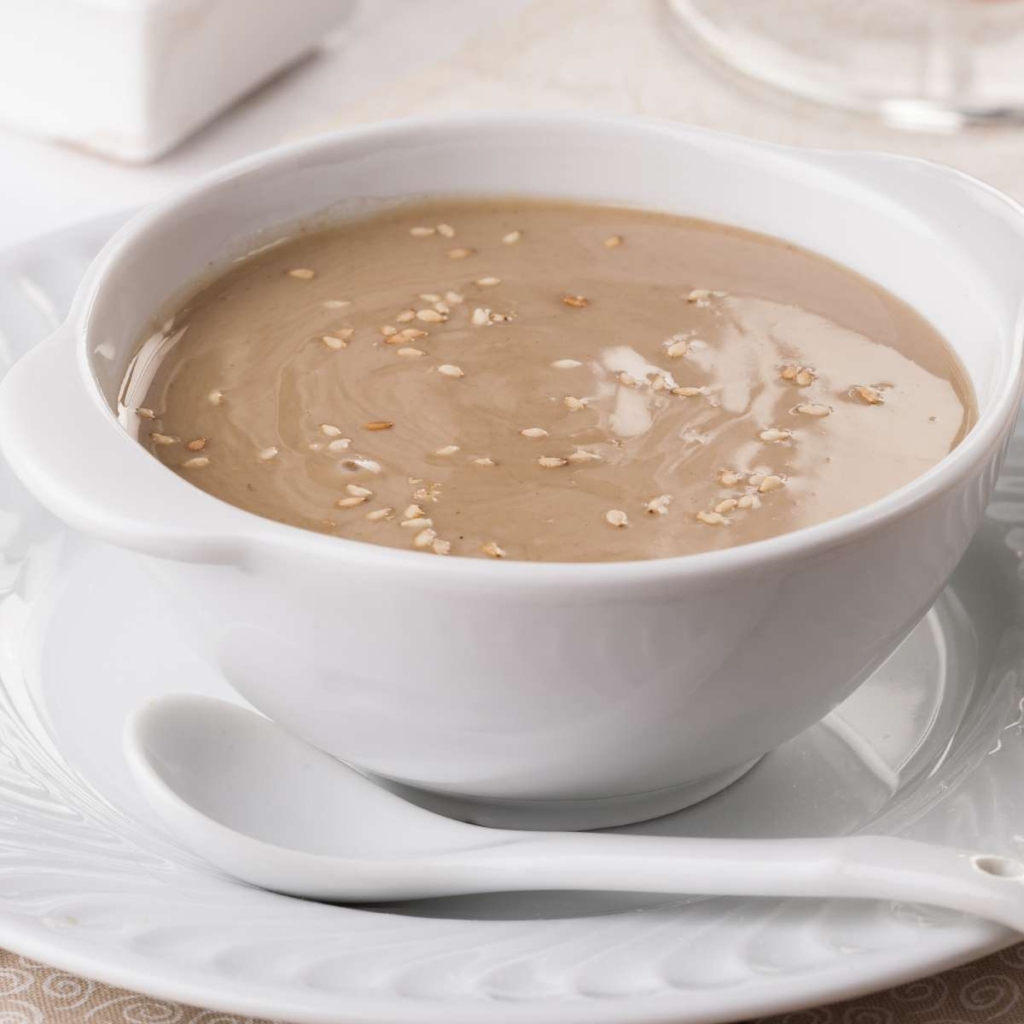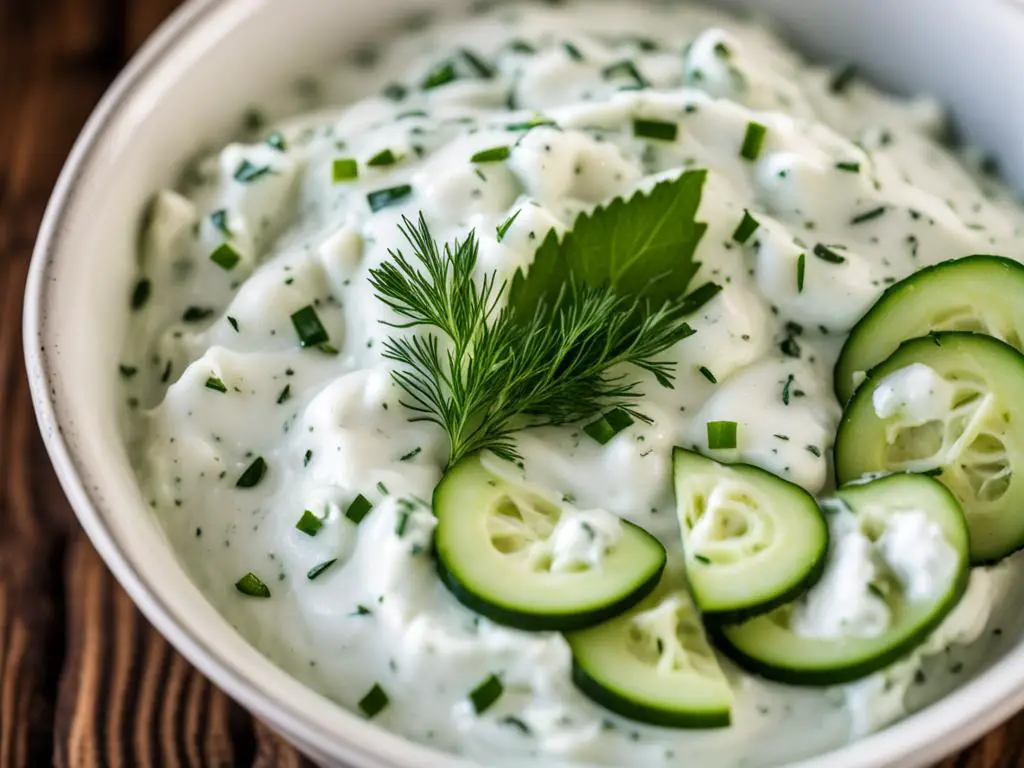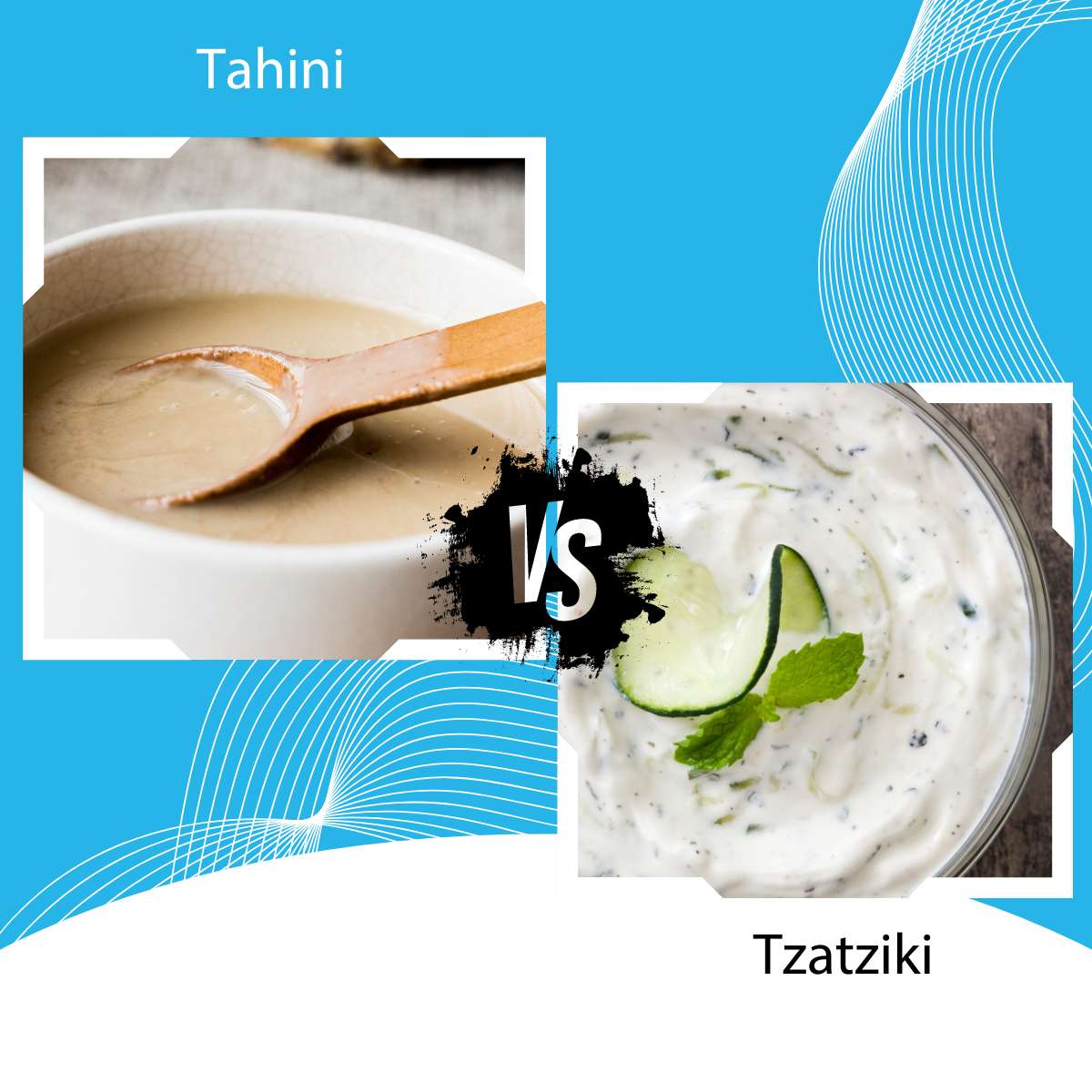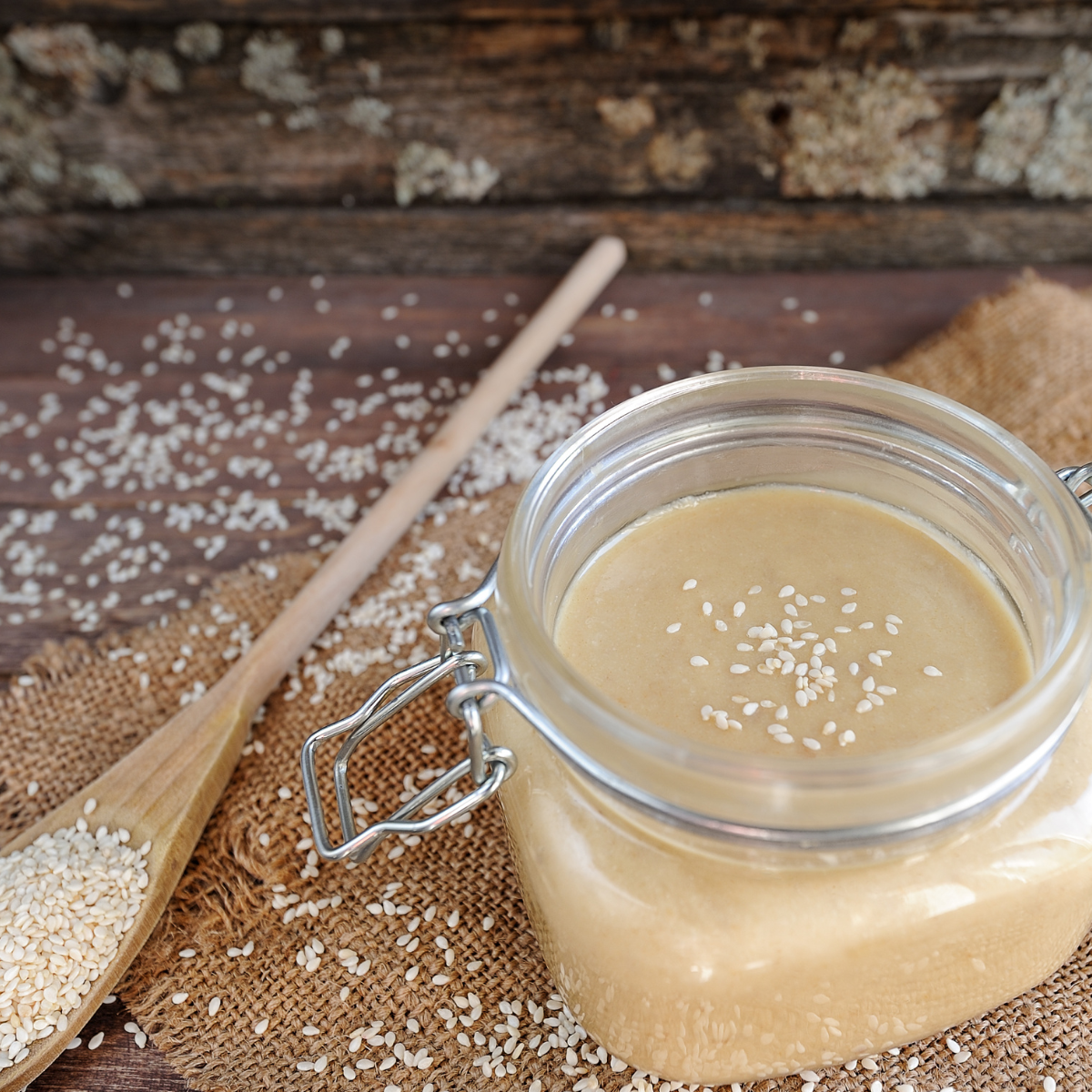Welcome, dip enthusiasts, to the flavor-packed showdown you’ve been waiting for: Tahini vs Tzatziki! It’s time to indulge in a dip duel that will leave your taste buds dancing with delight. Tahini is primarily made from ground sesame seed and looks like hummus, whereas tzatziki is a greek yogurt based sauce and looks like sour cream.
Let’s take a closer look.
The Versatility of Tahini

Tahini, a creamy paste made from ground sesame seeds, is known for its incredible versatility. It is a staple ingredient in Middle Eastern cuisine and can be used in a wide variety of recipes. From savory dips and sauces to sweet treats, tahini adds a unique nutty flavor and creamy texture to dishes. For nutritional content, see is tahini healthy.
It can be used as a base for dressings, as a spread on sandwiches, or as a key ingredient in baked goods. Its versatility makes it a must-have pantry staple for any adventurous home cook.
Tahini’s flavor profile also complements a wide range of ingredients. Its nutty taste enhances the earthiness of roasted vegetables, while perfectly balancing the richness of meats. Mix tahini with roasted red peppers, cumin, and lemon juice for a vibrant and flavorful hummus alternative.
Or, use tahini as a base for creamy salad dressings, combining it with yogurt, herbs, and a squeeze of lime for a refreshing twist.
But tahini isn’t just limited to savory dishes. Its unique flavor adds depth and richness to sweet treats as well. Combine tahini with honey, cinnamon, and oats to create indulgent energy balls or use it as a substitute for traditional nut butters in cookies and cakes. The creamy texture of tahini provides a delightful contrast to the sweet desserts.
Here are some ways you can incorporate tahini in your recipes:
- Whisk tahini with lemon juice, garlic, and salt to create a tangy salad dressing.
- Spread tahini on toast and top it with sliced bananas and a drizzle of honey for a quick and satisfying breakfast.
- Add tahini to smoothies for a creamy texture and a boost of healthy fats.
- Make a tahini-based sauce for roasted vegetables, combining it with yogurt, lemon juice, and a touch of tahini.
- Create a decadent tahini-topped brownie by swirling tahini into your favorite brownie batter before baking.
With its versatility and ability to add a unique flavor and creamy texture to a wide range of dishes, tahini is a valuable ingredient in any kitchen. Don’t be afraid to experiment and unleash the potential of tahini in your culinary endeavors.
The Flavorful Delight of Tzatziki
Tzatziki, a traditional Greek dip, is a delightful culinary creation that never fails to tantalize your taste buds. Bursting with refreshing flavors and boasting a creamy tex ture, this dip is a star in Greek cuisine. Made with a blend of yogurt, cucumbers, garlic, and herbs, tzatziki offers a harmonious combination of tangy, cool, and herbaceous notes that dance on your palate.
While tzatziki is most commonly known as a delightful dipping sauce for pita bread, grilled meats, and vegetables, its versatility extends far beyond being just a dip. With its bold flavor profile, tzatziki can elevate the taste of any Mediterranean-inspired dish, making it an essential component in the Greek culinary tradition.

Imagine adding a dollop of tzatziki to a freshly grilled lamb gyro, enhancing the succulent flavors of the meat with its cool and tangy essence. Or drizzle tzatziki on top of a crisp salad, transforming the ordinary into an extraordinary gastronomical experience.
Its creamy texture and herbaceous taste make it a versatile condiment, adding a delightful touch to sandwiches, wraps, or even as a dressing for Mediterranean-inspired pasta salads.
When it comes to Greek cuisine, tzatziki is an indispensable part of the culinary landscape. Its unique flavor profile and versatility make it a beloved addition to countless mouthwatering dishes. So, the next time you’re craving the taste of Greece, remember to reach for a jar of tzatziki and take your taste buds on a flavor-filled journey.
The Showdown: Tahini vs Tzatziki
When it comes to the battle of tahini vs tzatziki, both dips bring their A-game in terms of flavor and versatility. Let’s dive into a delicious comparison of these two culinary powerhouses.
Tahini: Rich, Nutty, and Versatile
Tahini, originating from Middle Eastern and Mediterranean cuisines, offers a rich and nutty flavor that elevates any dish it graces. Its smooth, creamy texture makes it a perfect match for both sweet and savory recipes. From hummus and salad dressings to baked goods and desserts, tahini lends its unique taste and versatility to a variety of culinary creations.
Whether you’re spreading it on toast, incorporating it into marinades, or using it as a dip, tahini adds a depth of flavor that brings dishes to a whole new level. Its ability to blend seamlessly with bold and savory ingredients makes it an exceptional choice for those looking to infuse their recipes with a touch of Middle Eastern flair.
Tzatziki: Refreshing, Tangy, and Herbaceous
On the other side of the ring, we have tzatziki, a refreshing Greek dip that tantalizes the taste buds with its tangy and herbaceous notes. Made with yogurt, cucumbers, garlic, and herbs, tzatziki delivers a delightful burst of flavors that complement Mediterranean dishes perfectly.
The cool and creamy texture of tzatziki makes it an ideal accompaniment to grilled meats, roasted vegetables, or simply as a dip for pita bread. Its refreshing taste helps balance out spicier dishes and adds a zesty touch to any meal. From gyros to dolmas, tzatziki brings a distinct flavor profile that celebrates the essence of Greek cuisine.
So, whether you’re seeking the nutty richness of tahini or the tangy delight of tzatziki, both dips have their own unique qualities that elevate dishes to new heights. The choice between the two ultimately depends on your personal taste preferences and the specific flavor profile you’re aiming for. Why not experiment with both and explore the infinite possibilities of tahini and tzatziki?
Now, let’s take a moment to appreciate the visual appeal of these tantalizing dips with a mouthwatering image:
With their distinct flavors and versatile applications, tahini and tzatziki are culinary contenders that are sure to elevate any dish. Whether you’re in the mood for the rich and nutty notes of tahini or the refreshing tang of tzatziki, these dips are guaranteed to add excitement to your culinary adventures. So go ahead, dip, dunk, and savor the flavors of tahini and tzatziki!
Conclusion
In the battle of tahini versus tzatziki, it’s a close call to determine the ultimate winner. Both dips bring their own unique flavors and versatility to the table, making them irresistible additions to any culinary adventure.
Tahini, with its rich and nutty taste, is a staple in Middle Eastern and Mediterranean cuisines. It adds depth and complexity to savory dishes, making it a go-to choice for those seeking bold and flavorful dips. Whether you’re whipping up a hummus or creating a vibrant salad dressing, tahini is a true culinary superstar.
On the other hand, tzatziki offers a refreshing and tangy flavor that brightens up any meal. With its creamy texture and herbaceous notes, it’s the perfect accompaniment to grilled meats, pita bread, or even as a salad dressing. Tzatziki brings a light and zesty touch to your taste buds, leaving you craving for more.
Ultimately, the verdict on the winner between tahini and tzatziki lies in your personal preferences and the specific dish you’re preparing. Whether you’re in the mood for a robust and savory dip or a lighter and zestier condiment,
both tahini and tzatziki will elevate your culinary creations and leave your guests asking for more. So why not add both to your next feast and let your taste buds revel in the flavorful versatility of these delightful dips?
FAQ
How do I use tahini in recipes?
Tahini can be used as a base for dressings, spread on sandwiches, or as a key ingredient in baked goods. Its versatility allows it to be used in a wide variety of recipes.
What are some common uses for tzatziki?
Tzatziki is commonly used as a dipping sauce for pita bread, grilled meats, and vegetables. It can also be used as a condiment or dressing to enhance the flavor of various dishes.
What flavors does tahini bring to dishes?
Tahini brings a rich and nutty taste to dishes. Its bold and savory flavor pairs well with a variety of ingredients and cuisines.
How would you describe the flavor of tzatziki?
Tzatziki offers a refreshing and tangy flavor with a balanced combination of coolness and herbaceousness. It complements Greek and Mediterranean dishes perfectly.
Which dip is better, tahini or tzatziki?
Both dips offer their own unique flavors and versatility, making it difficult to choose a clear winner. The choice ultimately depends on personal preference and the specific dish being prepared.


